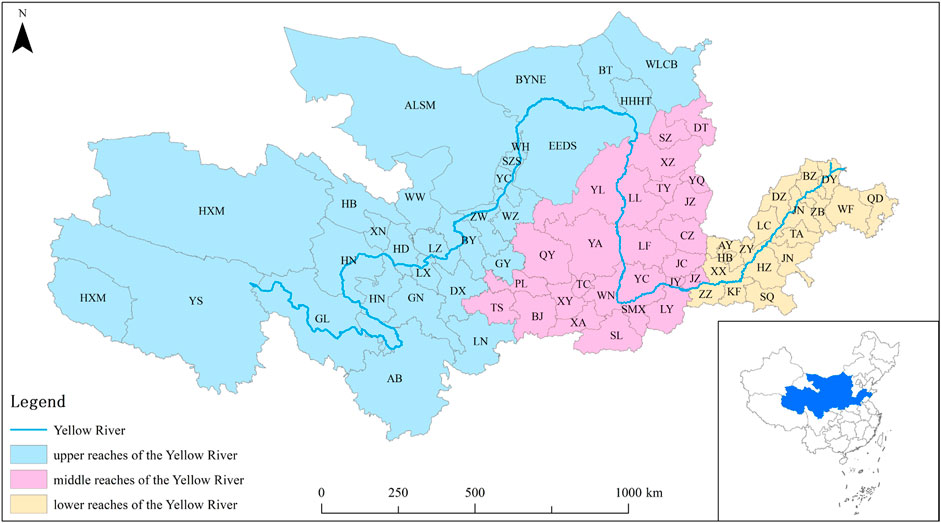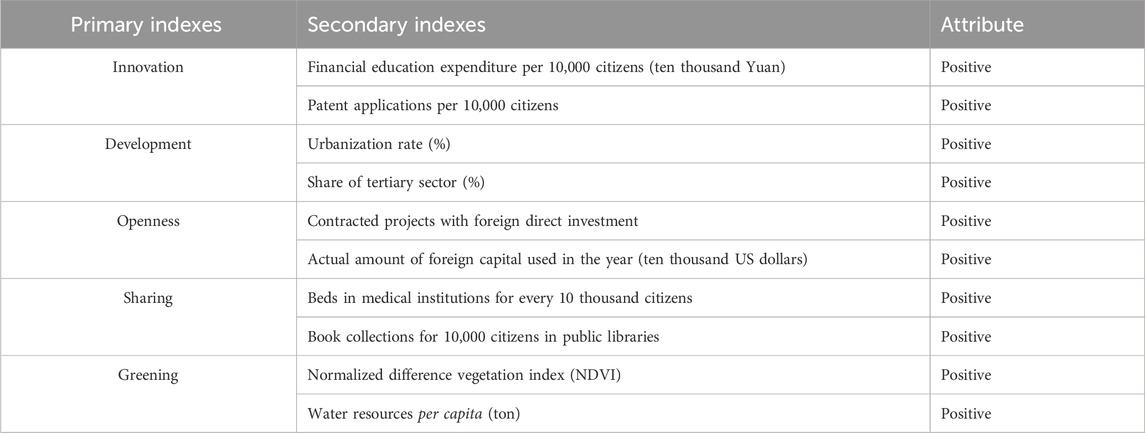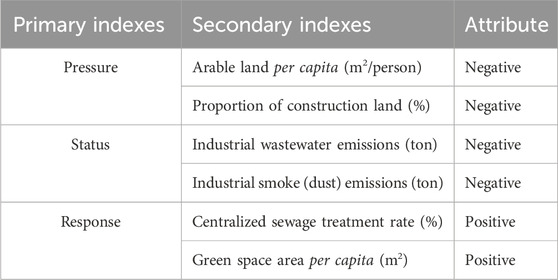How does the coupling coordination between high-quality development and eco-environmental carrying capacity in the Yellow river basin over time?
- 1School of Electronic and Information Engineering, Lanzhou Jiaotong University, Lanzhou, China
- 2School of Electronic and Electrical Engineering, Lanzhou Petrochemical University of Vocational Technology, Lanzhou, China
- 3College of Earth and Environmental Sciences, Lanzhou University, Lanzhou, China
- 4College of Environment and Resource, Southwest University of Science and Technology, Mianyang, China
Introduction: The Yellow River Basin is an important national energy base and ecological protection area, and it is of great significance to promote the coordinated development of high-quality development and eco-environmental carrying capacity in the region.
Methods: Taking the 73 prefecture-level cities along the Yellow River as the study unit, this paper measures the changes of high-quality development level and eco-environmental carrying capacity of municipalities from 2005 to 2020, using the coupling coordination degree model and fuzzy logic algorithm.
Results and discussion: 1) The capital city and its surrounding cities have a high level of high-quality development, with the lower and middle reaches of the Yellow River having higher levels than the upper reaches. From 2005 to 2020, the level of high-quality development showed an upward trend. 2) The eco-environmental carrying capacity of cities in the lower reaches is higher than that in the upper reaches. From 2005 to 2020, the eco-environmental carrying capacity of cities in the lower reaches of the Yellow River increased first and then decreased. 3) The provincial capital cities have a high degree of coupling coordination, with cities in the lower reaches having a higher level than those in the middle and upper reaches. A high degree of coupling coordination reduces spatial differences, but dominated by primary coordination. 4) From 2005 to 2020, the eco-environmental carrying capacity tended to be coordinated with the high-quality development, close to a high level and system optimization. In the end, we conclude with policy recommendations to promote high-quality urban development and harmony between people and nature in the region.
1 Introduction
According to the report of the 19th National Congress of the Communist Party of China, China’s economic development has entered a new era, shifting from a stage of high-speed growth to a stage of high-quality development. High-quality development is based on new ideas, with innovation as the primary driving force, coordination as an endogenous feature, green as a universal form, openness as the only way, and sharing as the fundamental purpose of development. The carrying capacity of the ecological environment refers to the intensity of human activities that the ecosystem can withstand. Therefore, promoting the coordination of high-quality development and ecological environmental carrying capacity is of positive significance to promote regional economic development and ecological harmony. The Yellow River is an important ecological barrier in China. In September 2019, General Secretary Xi Jinping put forward five suggestions on the ecological protection and high-quality development of the Yellow River Basin at a symposium on ecological protection and high-quality development in Henan Province; in October 2021, he stressed the necessity of scientific analysis of the current ecological protection and high-quality development situation at a symposium on the in-depth promotion of ecological protection and high-quality development of the Yellow River Basin, pointing out that we should implement the strategic plan of ecological protection and high-quality development, and unswervingly take the modern road of ecological priority and green development. All the above reflects the importance of the Yellow River Basin. The eco-environmental carrying capacity and high-quality development of the Yellow River Basin in the new era are related to China’s food security, energy security, ecological security and cultural heritage (Li et al., 2019; Jin et al., 2020).
The Yellow River Basin itself has a long-standing contradiction between water resources supply and demand, and frequent flood disasters. On this basis, the ecological environment around the basin, especially in the source area of Kariqu in Qinghai Province, is fragile and the protection task is heavy. The economic development of the Yellow River Basin has been constrained by the ecological environment for a long time, but the Yellow River itself has brought some assistance to urban development, industry and agriculture. There is a mutual constraint and interaction between ecological civilization construction and high-quality development. It is of great significance to analyze the coupling between the long-term contribution of ecological protection and high-quality economic development, and the existing level of ecological environment carrying capacity, in order to propose future synchronous improvement strategies.
The ecological environment of the Yellow River Basin has always been the focus of scholars’ research, and as early as the 1980s, scholars proposed the impact of ecological damage on economic development (Wang, 1988). In the 1990s, Luo analyzed the ecological and environmental problems of agricultural development, such as soil erosion, land wind erosion, and soil salinization from the perspective of sustainable agricultural development (Luo et al., 1995). In addition, there has been an increase in research on its ecological and environmental issues and on its coordinated development, such as the establishment of the concept of coordinated ecological and economic development proposed by Zhu (1994). Hou analyzed the main ecological problems in the source area and proposed sustainable development countermeasures (Hou et al., 2001). Therefore, it is of great significance to attach importance to the relationship between ecological environment and regional development to promote coordinated development.
With the ecological carrying capacity and high-quality development of the Yellow River Basin identified as a national strategy in 2019, the ecological environment and high-quality development of the region have received widespread academic attention. High-quality development involves the connotation, basic conditions, core strategies and measurement of a high-quality development construction index system (Xu et al., 2020; Yang et al., 2020). The study on the ecological carrying capacity includes analysis of its spatial and temporal evolution, ecological vulnerability assessment and prediction, and ecological restoration (Yang et al., 2021; Ru and Ma, 2022; Zhang, 2022). In addition, early in the 1990s, Grossman proposed the widely being used environmental Kuznets curve (EKC) hypothesis about the coupling relationship between economic growth and ecological environment (Grossman and Krueger, 1992; Saleem, 2019; Dogan and Inglesi-Lotz, 2020).
Moreover, the coupling coordination of ecology, environment, economy and energy, one of the keys to the high-quality development of the Yellow River Basin, is of great significance to promote the sustainable development of the region (Zhao et al., 2021a; Zhao et al., 2021b). Liu analyzed the coupling coordination relationship between economic development and ecological environment in 36 cities in the Yellow River Basin, and pointed out that the coordination between economic development and ecological environment needs to be urgently addressed (Liu et al., 2020). Therefore, there are many studies focusing on the coordinated development of the two, such as Yu paid attention to ecological protection and high-quality development issues and made suggestions (Yu and Fang, 2020). Gen placed their focus on the relationship between ecology, tourism and urbanization (Gen and Shao, 2022). Zhu studied the relationship between carbon emissions and economic development (Zhu et al., 2021). Many scholars, such as Cui et al., with focus on the coupling coordination relationship between the two, constructed a system of ecological environment and high-quality development indexes to analyze their temporal and spatial coupling characteristics (Cui et al., 2020). Sun chose the evaluation and trends of coupling coordination as their perspective in study (Sun, 2021). Xin studied the coupling coordination between eco-environmental protection and high-quality development in the Yellow River Basin using data from 2003 to 2018, and concluded that the coupling coordination improved year by year across the Yellow River Basin. They also predicted that the eco-environmental protection and high-quality development of the Yellow River Basin will step into a coordinated stage by 2019–2023 (Xin and Liu, 2022).
In summary, the research on the coupling and coordination between the carrying capacity of the Yellow River Basin’s ecological environment and the level of high-quality development is in a mature stage of continuous improvement. However, there are problems such as one-sided selection of measurement indicators, incomplete perspectives, and insufficient research on urban data. The spatiotemporal evolution laws need to be further revealed. It is imperative to further explore and improve the coupling coordination degree and collaborative development path of the ecological environment carrying capacity and high-quality development in the Yellow River Basin. Based on this, this article improves the two basic aspects of data selection and measurement, quantitatively judges the degree of ecological and economic coordinated development in the Yellow River Basin, which is conducive to scientifically evaluating the rationality of the development model of the Yellow River Basin and providing decision-making reference for achieving regional sustainable development.
This paper tries to answer two questions:
(1) How does the coupling coordination between high-quality development and eco-environmental carrying capacity of cities in the Yellow River Basin change over time?
(2) What is the strategy of coupling coordination between high-quality development and eco-environmental carrying capacity of cities in the Yellow River Basin?
2 Study area and data sources
The Yellow River basin is bounded by Kunlun in the west, Yinshan in the north, Qinling Mountains in the south and Bohai Sea in the east, middle and western parts of China. It is an important ecological security barrier, an important area for population activities and economic development, and plays a pivotal strategic role in the overall development of the country and the overall socialist modernization drive in China. However, the Yellow River has always been “weak and sickly”, with poor ecological background, shortage of water resources, serious soil erosion and weak carrying capacity of resources and environment. The unbalanced and inadequate development of provinces and regions along the Yellow River is particularly prominent.
The Yellow River Basin is a geographic and ecological area affected by the Yellow River system from its source to its confluence with the sea. It is customary to call the provinces and regions through which the Yellow River flows collectively the Yellow River Basin. The watershed spans four geographic units: the Qinghai-Tibet Plateau, the Inner Mongolia Plateau, the Loess Plateau and the Huanghuaihai Plain, from west to east. The Yellow River, known as the Great River in ancient China, originates from the Bayan Har Mountains in Qinghai Province, China, and flows through 9 provinces and regions: Qinghai, Sichuan, Gansu, Ningxia, Inner Mongolia, Shaanxi, Shanxi, Henan, Shandong, finally joining the Bohai Sea in Kenli District, Dongying, Shandong Province (Wang et al., 2020; Zhao et al., 2021c). In this paper, 73 prefecture-level cities (Figure 1) along the Yellow River are studied and a total of 57 cities are included in the calculation (except for 16 with some data missing due to their remote location and long-time span).
The original indexes used in this study come from the statistical data of cities and the statistical yearbooks of 9 provinces (autonomous regions) in the Yellow River Basin from 2005 to 2020, with 2005, 2010, 2015 and 2020 as four time nodes.
3 Index system construction and measurement
3.1 Index system construction
3.1.1 High-quality development index system
According to relevant studies, the selection of high-quality development evaluation index system is mainly based on the understanding of its connotation, including the construction of index system based on the five concepts for development (Li and Ren, 2019; Sun et al., 2023), or the inclusion of “the contradiction between people’s ever-growing needs for a better life and unbalanced and inadequate development” into the index system (Guo et al., 2020). The selection of the indexes for the high-quality development of cities in the Yellow River Region complies with the principles of being scientific, systematic and accessible. Based on the five development concepts of “innovation, development, openness, sharing and greening”, the paper introduces five primary indexes of innovation, development, openness, sharing and greening according to the existing research results (Li and Liu, 2022) depending on the actual conditions of the Yellow River Basin, as shown in Table 1.
3.1.2 Eco-environmental carrying capacity index system
The eco-environmental carrying capacity is the ability of the resource and environmental subsystems to supply and maintain a certain intensity of socio-economic activities and population under specified conditions, given that the ecosystem is able to self-sustain and self-regulate. According to the existing literature (Liu et al., 2021) and the reality of the study area, this paper constructs ecological and environmental carrying capacity evaluation indexes based on three dimensions of pressure, status and response, including 2 secondary pressure indexes based on population growth and urbanization level, 2 status indexes based on pollution emission and 2 response indexes based on environmental management, a total of 6 indexes, as shown in Table 2.
3.2 Measurement of high-quality development level and eco-environmental carrying capacity
3.2.1 Fuzzy logic algorithm
In classical binary logic, “1” and “0” are usually used to indicate the truth or falsity of a proposition. In practice, a proposition is no longer true or false, but “partially true”, and usually expressed in terms of affiliation as a transition value between [0–1], which is called fuzzy logic and used to identify a degree. It is more effective in capturing the approximate and imprecise values of vague concepts with clear connotations and unclear extensions, so that the measurement results are closer to reality. It has been widely used in recent years (Iancu, 2018; Shruti et al., 2020). This paper constructs an index system for high-quality development level from five prospectives of “innovation”, “development”, “openness”, “sharing” and “greening”, and measures eco-environmental carrying capacity in three ways: “pressure”, “status” and “response”. These are fuzzy problems and the measurement of high-quality development level and eco-environmental carrying capacity by fuzzy logic algorithm can offer a more reliable result. According to the relevant literature, the fuzzy logic algorithm includes three steps: fuzzifying the definite value using the subjection function; conducting fuzzy inference by fuzzy rules; and defuzzifying the fuzzy output to get the definite value (Zhao et al., 2013).
(1) Fuzzifying
In this paper, 10 indexes of high-quality development level and 6 indexes of eco-environmental carrying capacity are measured by two fuzzy logic models, and both input and output indexes are measured by triangular subjection functions:
Where, x represents index value, and
(2) Establishment of fuzzy rules
In the algorithm, “if-then” is used to establish rules as in Equation 2 and Mamdani method is adopted for fuzzy reasoning.
Where,
(3) Defuzzifying
The center-of-gravity method is used to defuzzify and get the output value. That is, the center of gravity of the area enclosed by the subjection function curve and the horizontal coordinate is taken as the final output value of the fuzzy logic inference, calculated as follows:
Where, y represents the calculated result based on all indexes,
3.2.2 Coupling coordination degree model
In this paper, the synergy between the high-quality development (HD) level and the eco-environmental carrying capacity (ECG) is measured using a coupling coordination degree model (Wang et al., 2021), as shown in Eq. 4–6:
Where,
3.2.3 Relative development degree model
The coupling coordination degree model reflects the coupled coordination relationship between eco-environmental carrying capacity l and high-quality development, but t fails to clearly show the relative development degree of both, so the relative development model is introduced to seek the relative development index of both, which has been widely used in this field (Bi et al., 2017; Qi and Zhang, 2022). The calculation formula is shown in (7).
Where, D represents the relative development degree, EGG and HD represent the eco-environmental carrying capacity value and the high-quality development level value, respectively. According to the studies available and the calculated coupling coordination, the coupling coordination is classified into 3 categories by the criteria as shown in Table 3.
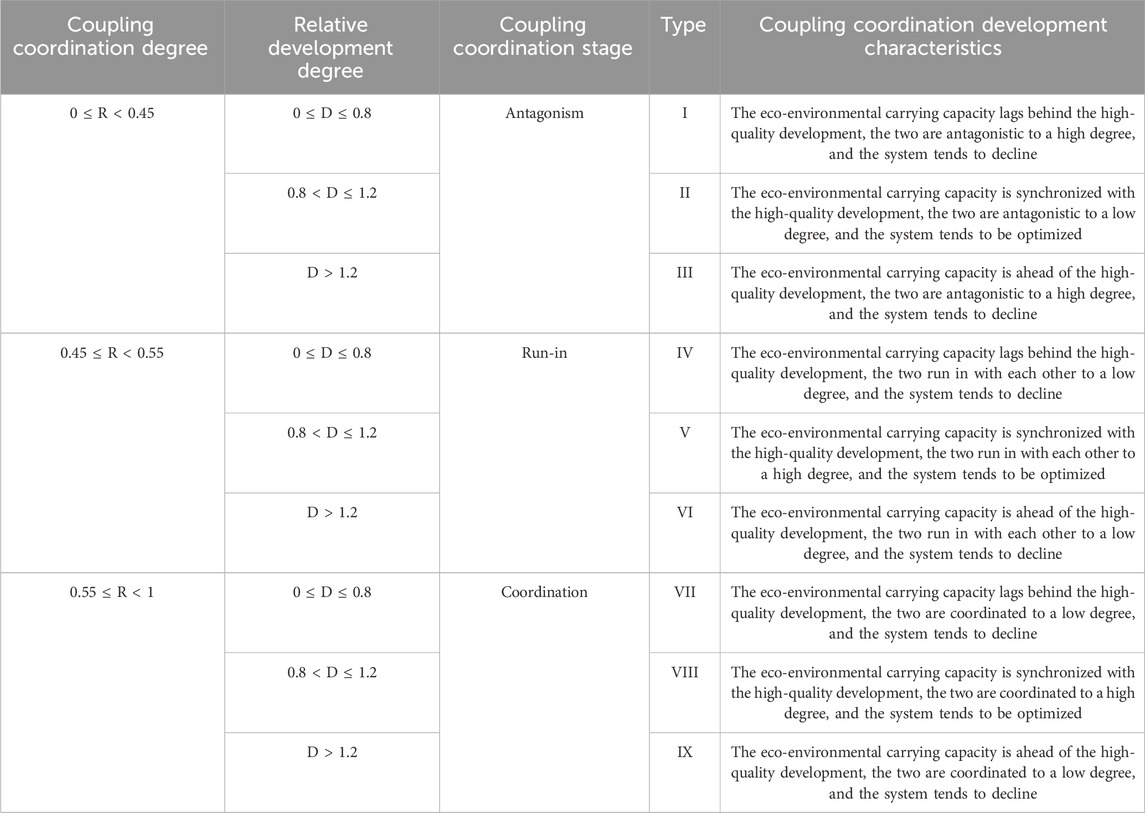
Table 3. Criteria for dividing the stage of coupling coordination between eco-environmental carrying capacity and high-quality development level.
4 Results and analysis
4.1 Spatial and temporal patterns of high-quality development level changes in the cities of the Yellow river basin
According to the calculation, the mean values of high-quality development level in the Yellow River Basin in 2005, 2020, 2015 and 2020 were 0.353, 0.417, 0.453 and 0.469 respectively, in a rising trend. It is equally divided into four categories according to its range of distribution, as shown in Figure 2. The Yellow River Basin is characterized by significant spatial differences in high-quality development, specifically, 1) provincial capitals in the Yellow River Basin have a high level of high-quality development, with a higher level in the lower reaches than in the upper reaches, showing the rank-size rule to some extent; 2) cities in the middle and lower reaches of the Yellow River Basin have a higher quality development level than those in the upper reaches in general, for example, some cities in Shandong Province in the lower reaches and some cities in Shanxi Province in the middle reaches have a high level of high-quality development, while some cities in Gansu Province and Ningxia Hui Autonomous Region in the upper reaches, such as Tianshui and Zhongwei are at a low level as “development depressions”.
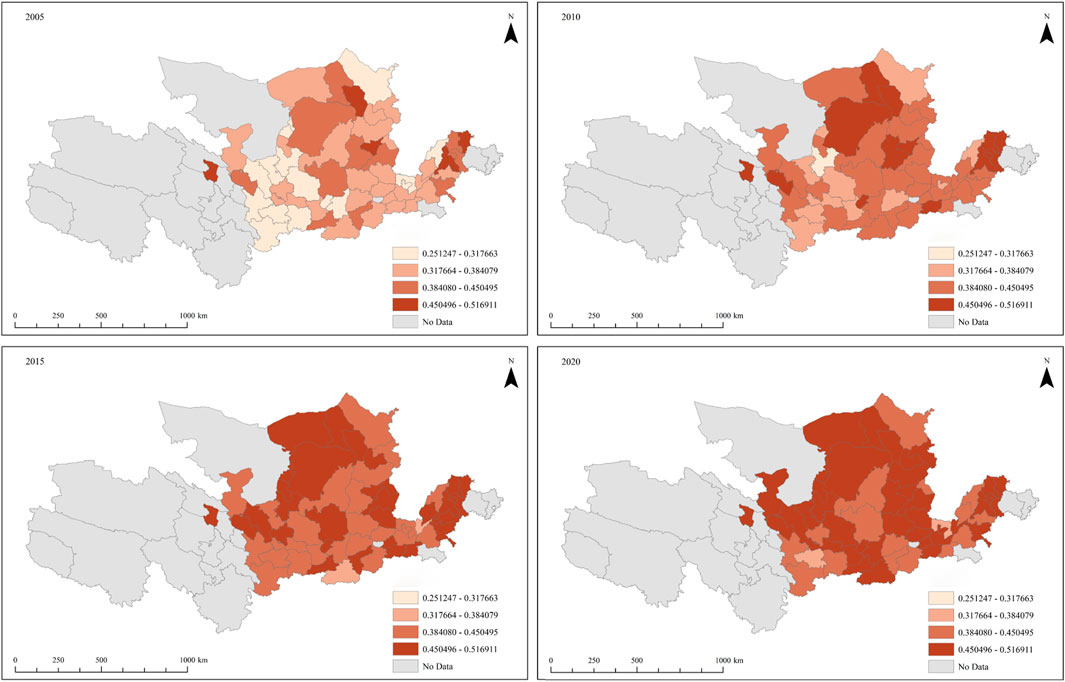
Figure 2. Changes in the high-quality development level in the Yellow River Basin from 2005 to 2020.
During the period from 2005 to 2010, the high-quality development level in the Yellow River Basin showed an upward trend. Cities with a high level of quality development witnessed a significant increase, but there were great differences between basin segments. The upper reaches also saw an improvement in quality development, with some cities, such as Baiyin and Dingxi, improving by 2 grades, albeit at a low level; the middle and lower reaches improved by 1 grade, with the range mainly increasing from 0.318 to 0.384 to 0.384–0.450. From 2010 to 2015, the level of high quality development in the Yellow River Basin mainly ranged from 0.450 to 0.517, with the number of cities in the high value range increased considerably and the degree of high quality development improved significantly, mainly distributed in the surrounding cities centered on the provincial capital, that is, provincial capital cities played an obvious driving role. The rest of the cities improved at a relatively slow pace, especially in the middle and lower reaches. 3) From 2015 to 2020, the high quality development level mainly ranged from 0.450 to 0.517 across the river basin, with a reduction in the difference between cities.
Overall, the cities in the Yellow River Basin showed an upward trend in the level of high quality development, with the provincial capital cities as the center and the high-value areas gradually expanding outward.
4.2 Spatial and temporal patterns of eco-environmental carrying capacity changes in the cities of the Yellow river basin
Based on the calculation results, the eco-environmental carrying capacity level values at four time points are divided into four levels according to the equipartition principle, as shown in Figure 3. Overall, cities have obvious spatial differences in ecological carrying capacity, with provincial capitals at a higher level and the lower reaches higher than the middle and upper reaches. From the perspective of time, the average eco-environmental carrying capacity of the Yellow River Basin in 2005, 2010, 2015 and 2020 was 0.463, 0.472, 0.487 and 0.480, respectively, indicating that the eco-environmental carrying capacity of the Yellow River Basin increased first and then decreased.
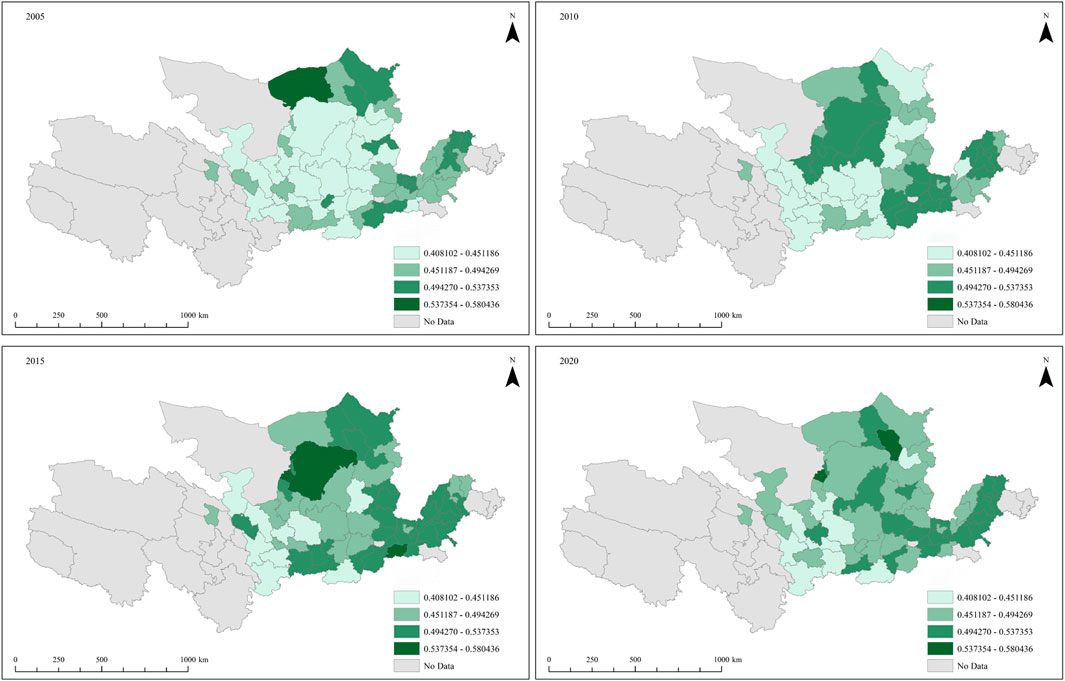
Figure 3. Changes in the eco-environmental carrying capacity of the Yellow River Basin from 2005 to 2020.
Specifically, 1) from 2005 to 2000, the ecological carrying capacity of cities was low but still improving, mainly in the middle and upper reaches such as Jinan, Zhengzhou, Yinchuan and their surrounding cities; 2) from 2010 to 2015, the number of cities with ecological environmental carrying capacity of the third and fourth levels increased significantly, showing an increasing trend from cities in the lower reaches to cities in the middle and upper reaches; 3) from 2015 to 2020, the eco-environmental carrying capacity increased in some cities, but showed a downward trend, with a decrease in cities north of the lower Yellow River and a small change in the middle reaches. Some of the cities of the Inner Mongolia Autonomous Region in the upper reaches experienced larger declines, but some cities in Gansu Province experienced a smaller change.
In summary, from 2005 to 2020, the eco-environmental carrying capacity of some cities in the upper reaches in Gansu Province remained at a low level for a long time, while that of cities in the middle and lower reaches increased first and then decreased with a small range.
4.3 Coupling coordination degree between high-quality development level and eco-environmental carrying capacity
The average degree of coordinated development for the four periods was 0.579, 0.633, 0.658 and 0.671, respectively, implying an increase in the coupling coordination between the level of high-quality development and the eco-environmental carrying capacity. According to Wang et al. (Wang et al., 2021), it is classified into four categories: bordering loss coordination, barely coordination, primary coordination, and intermediate coordination, as shown in Figure 4. From the perspective of regional differences, the provincial capital cities have a high coupling degree, and it is higher in the lower reaches than in the middle and upper reaches. From the perspective of time, 1) the number of first-level coordinated cities increased significantly from 2005 to 2010, reflected in the middle and lower reaches; the number of cities with medium coordination increased somewhat, such as Erdos and Baotou; 2) from 2010 to 2015, most cities were mainly in primary coordination with little change, except for cities in the upper reaches that were upgrading from barely coordinated to initially coordinated, such as Qingyang and Pingliang; in addition, cities with medium coordination saw an increase from the lower reaches to the upper reaches. 3) From 2015 to 2020, the whole basin experienced little change, still dominated by primary coordination, with some cities of Shandong Province in the lower reaches staying in intermediate coordination.
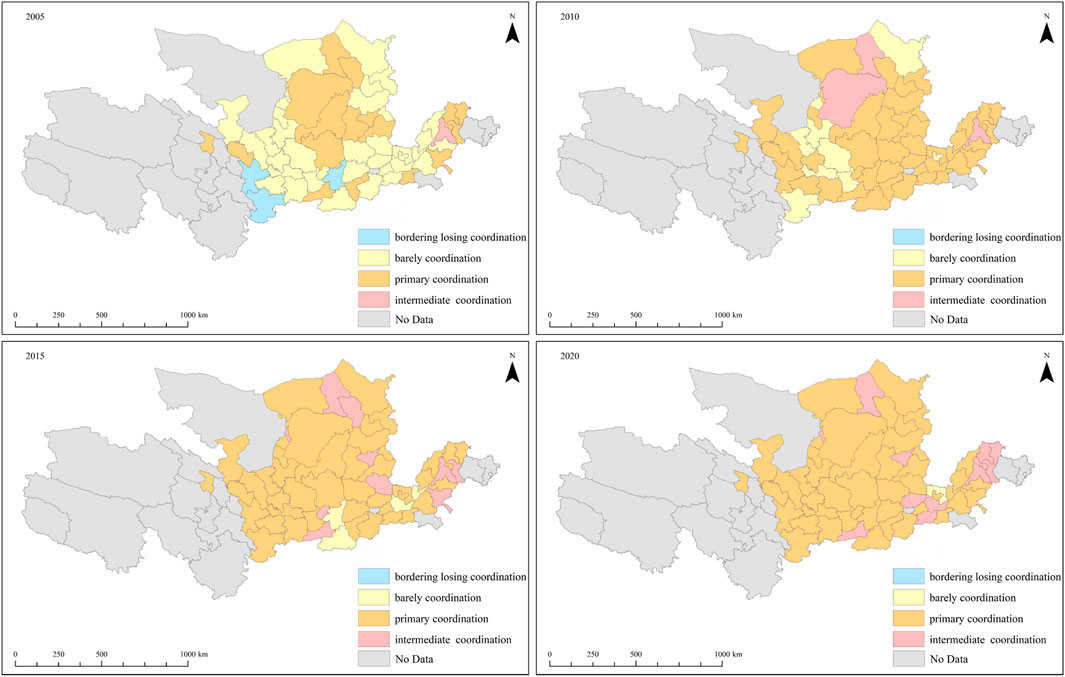
Figure 4. Coupling coordination degree between high-quality development level and eco-environmental carrying capacity of the Yellow River Basin from 2005 to 2020.
Overall, cities in the Yellow River basin were dominated by primary coordination, with a steady upward trend and a gradual reduction of inter-city differences.
4.4 Coordinated variation path of high-quality development and ecological environment
The results of the calculations are classified according to the relative development degree model, as shown in Figure 5. From 2005 to 2020, there were three categories of coupling coordination between eco-environmental carrying capacity and high quality development level, that is, VI, VIII and IX, dominated by run-in and coordination. On the whole, the degree of coordination between ecological environmental carrying capacity of the Yellow River Basin and the level of high-quality development tended to be coordinated, the spatial differences decreased, the two tended to be highly coordinated and the system tended to be optimized.
(1) In 2005, the relationship between the two included coordination and run-in. In the coordinated cities, Jinan, Taiyuan, Hohhot, Lanzhou and other cities and their surrounding cities were synchronized with the high-quality development level, and the two were highly coordinated, with the system to be optimized. The eco-environmental carrying capacity of other cities in the middle and lower reaches was ahead of the high quality development level, mainly at a low level of coordination, with the system tending to decline. The cities in the run-in stage were mainly distributed in Gansu Province, and their eco-environmental carrying capacity was ahead of the high quality development level, with the system tending to decline.
(2) From 2010 to 2020, there was a significant increase in the number of cities with optimized systems, except for some cities with the system tending to decline featured by a low level of coordination and eco-environmental carrying capacity ahead of the high quality development level, such as Tianshui, Baoji, Xianyang, Weinan and other southern cities.
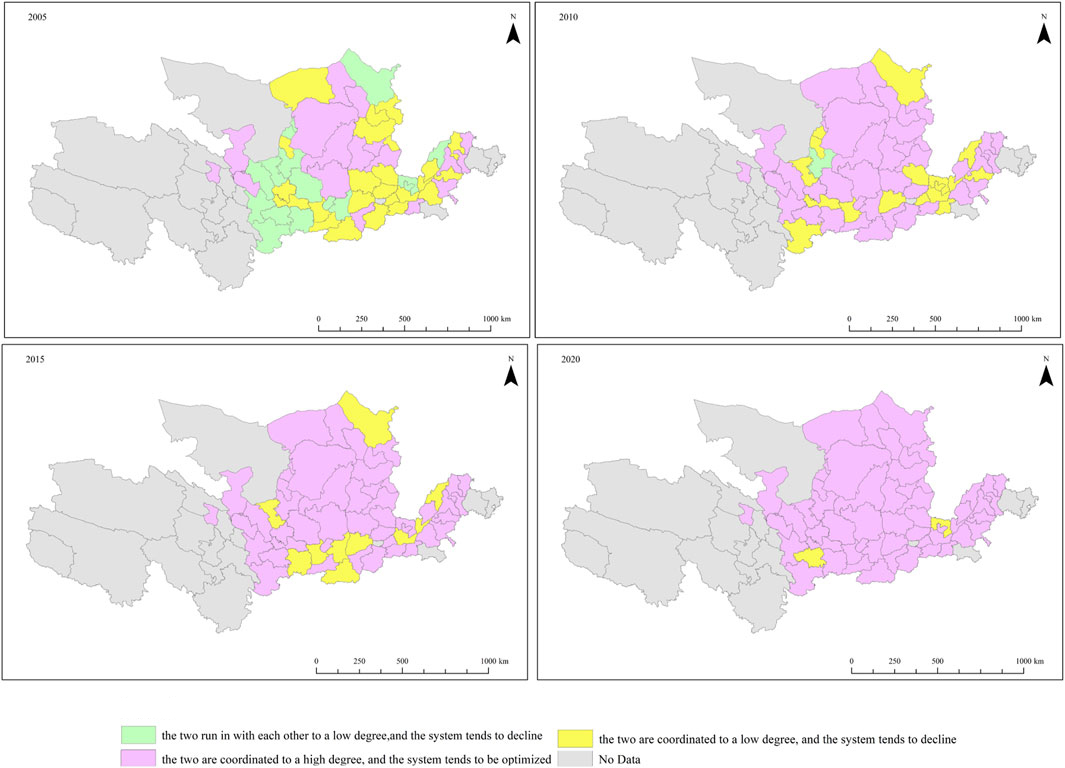
Figure 5. Changes in the coordinated development path of high-quality development and ecological environment in the Yellow River Basin from 2005 to 2020.
5 Conclusions and discussion
5.1 Conclusions
In this paper, we constructed a high-quality development level index system and an eco-environmental carrying capacity index system from the perspective of cities and studied the high-quality development level, the ecological environmental carrying capacity of the Yellow River Basin, and the coupling coordination between them, as well as the coordinated development path of the two. The findings are mainly as follows:
(1) The lower reaches of the Yellow River have a higher level of high-quality development than the upper reaches, with the western inland areas being development depressions. The provincial capital cities in general have a high level of high-quality development, and the high-quality development of surrounding cities is driven by the laws of order and scale.
(2) From 2005 to 2020, there was a significant spatial difference in eco-environmental carrying capacity. It was higher in the lower reaches of the Yellow River than in the upper reaches, showing a trend of first increasing and then decreasing.
(3) The coupling coordination degree between high-quality development level and eco-environmental carrying capacity of cities decreases from the upper reaches to the lower reaches, but the difference in spatial distribution gradually decreases, and the degree of coupling coordination between the two shows an upward trend with small fluctuations.
(4) The coordinated development path of eco-environmental carrying capacity and high-quality development level showed a trend of “run-in - coordination” from 2005 to 2020 in cities, and the relationship between the two shifted from eco-environmental carrying capacity ahead of high-quality development level to synchronous change, with the system changing from decline to optimization.
5.2 Discussion
Based on the above findings, the following policy suggestions are made to promote the high-quality development of cities in the Yellow River Basin and to promote the harmony between people and nature in the region.
5.2.1 As for high-quality development level
It is necessary to coordinate the high-quality development level of cities in the upper and lower reaches and enhance the role of the provincial capital cities in driving high-quality development. First of all, cities in the Yellow River Basin should make use capital and construction land indexes in a relatively concentrated manner, with focus on improving the competitiveness of central cities, strengthening the construction of urban clusters, and getting deeply involved in the regional division of labor and cooperation at the national level. In addition, they should reconfigure the spatial structure of high-quality development in the basin by building a modern regional development system of “urban cluster-development axis-economic zone” to improve competitiveness.
Inland cities in the Yellow River Basin should build on their comparative advantages and resource endowments, and actively establish relations with neighboring cities to drive their own development. First, they should keep developing industries with distinctive local features, expand income channels, promote the extension of infrastructure and public services to rural areas, gradually alleviate the imbalance between urban and rural development. Second, it is necessary to actively integrate into the national strategy and accelerate the step to the world in the wave of smart society and globalization, that is, to actively and continuously explore new industrial development models in the region that suit the national needs and their own, and to construct distinctive and competitive industrial clusters/chains to seek high-quality growth.
5.2.2 As for eco-environmental carrying capacity
It is necessary to enhance the eco-environmental carrying capacity of cities in the upper reaches of the Yellow River Basin, with focus on improving the eco-environmental carrying capacity of provincial cities. Equal importance should be attached to ecological protection, restoration and construction with environmental protection as the starting point. First, in view of the serious environmental pollution caused by industrial “three wastes” emission and excessive application of chemical fertilizers in the Yellow River Basin, it is necessary to improve the environmental condition of the Yellow River Basin by controlling the excessive emission of pollutants and enhancing environmental pollution control to improve the efficiency of resource and energy use. Second, to improve the ecological condition of the Yellow River Basin, it is not only necessary to consider the Yellow River Basin as an organic whole and improve the overall ecological condition of the whole basin, such as strengthening the construction and management of protected areas and enhancing the construction of urban parks and green areas, but also to fully consider the differences in ecological protection in the upper, middle and lower reaches and follow the principles of classified development and collaborative development, such as strengthening the water conservation capacity in the upper reaches, improving the soil and water conservation capacity in the middle reaches, and moderately increasing the biodiversity in the lower reaches to balance the differences in regional resource supply capacity by reasonable resource allocation across regions.
Cross-regional resource allocation should be carried out to balance the differences in regional resource supply capacity. In view of the differences in natural environment, climatic characteristics and resource endowment of different regions in the Yellow River Basin, it is necessary to explore the development paths and models for different areas in the upper and middle reaches as well as both banks of the Yellow River Basin according to the regional carrying capacity and suitability (Zhao, 2020). Local governments should strengthen ecological control, reduce the introduction of highly polluting enterprises, and gradually reduce the incremental amount of pollution by means of economic structure transformation; in addition, they should restore green mountains and turn them into treasures through ecological industrialization and industrial ecologicalization, so as to reduce pollution while creating economic increment. In addition, efforts should be made around “transformation, upgrading and greening” in the industrial development. The ecological economy should be developed according to local conditions, to promote the ecological transformation of traditional industries with focus on cultivating new driving forces for green development.
Strict legislation and law enforcement are needed to establish a sound punishment mechanism and to control acts that damage the ecological environment. First, it is necessary to strengthen the construction of environmental management laws and regulations and improve the ecological compensation mechanism. Second, financial subsidies should be provided to key areas of ecological environmental protection and resource-based economic transformation areas, and the investment should be increased moderately in nature reserves and functional ecological zones. Third, a resource compensation mechanism for inter-basin water transfer should be established in accordance with the principle of “whoever develops is responsible for protection, whoever uses should provide compensation”. Based on the systematic analysis of regional environmental capacity and environmental carrying capacity, effective measures for the implementation of the “three lines and one list” (ecological protection red line, environmental quality bottom line, resource utilization upper limit line and ecological access list) should be developed to protect the ecological environment to the maximum extent (Jin, 2019).
It is necessary to increase the investment in environmental protection, and ensure that the investment is sufficient to address the ecological and environmental problems faced by regions with low carrying capacity. The establishment of an ecological protection and high-quality development fund for the Yellow River Basin is a key measure to guarantee the great governance and protection of the basin. The Outline of the Plan has staked out the requirement of establishing a fund for ecological protection and high-quality development of the Yellow River Basin, and the relevant work should be started early. It is suggested that under the leadership of relevant national departments, financial institutions, as well as enterprises with strong strength and experience in river and lake management in the Yellow River Basin or even outside the basin, should jointly initiate the establishment of the ecological protection and high-quality development fund for the Yellow River Basin, positioned as a national industrial investment fund. As a funding platform, it will drive social capital to jointly participate in the management and protection of the Yellow River Basin (Zhang and Liu, 2021).
5.2.3 Coupling coordination and coordinated development path
It is necessary to promote the coordinated development between high-quality development and eco-environmental carrying capacity of the cities in the upper reaches of the basin, while keeping stable the coupling differences of cities in the upper and lower reaches with gentle changes, to achieve synchronized and coordinated development of the upper and lower reaches. The key to the coupling coordination of ecological protection and high-quality development is to give full play to the mutual positive promotion of the two subsystems, that is, to play the supporting role of ecological protection to high-quality development and the power role of high-quality development to ecological protection. Specifically, it is required to promote high-quality development relying on the resource guarantee, intensive orientation, wealth appreciation, and power switching functions of ecological protection; and to promote ecological protection relying on the restoration funding support, technology effect, structural effect, and system improvement functions of high-quality development.
Moreover, it is necessary to scientifically formulate ecological protection and high-quality development plans for the Yellow River Basin, and strengthen policy coordination and mechanism convergence between ecological protection and high-quality development by sticking to systematic planning and integration, to further improve the coordination of ecological protection and high-quality development in the Yellow River Basin. A flexible and scientifically differentiated economic-ecological coordination policy should be developed based on the spatial network characteristics of coupled economic-ecological coordination.
Data availability statement
The raw data supporting the conclusion of this article will be made available by the authors, without undue reservation.
Author contributions
LM: Methodology, Writing–original draft, Project administration, Validation. XZ: Writing–original draft, Investigation. BY: Writing–original draft, Conceptualization, Data curation. JF: Project administration, Resources, Visualization, Writing–review and editing. ML: Writing–review and editing, Investigation, Methodology, Writing–original draft. MW: Writing–original draft, Methodology, Formal Analysis, Software.
Funding
The author(s) declare that financial support was received for the research, authorship, and/or publication of this article. This work was supported by the National Natural Science Foundation of China (42201198), the Youth Science and Technology Fund of Gansu province (22JR5RA518), the Key Laboratory of Earth Surface System and Human-Earth Relations, Ministry of Natural Resources of China (LBXT2023YB09) and the Central University Basic Research Fund of China of lanzhou university (lzujbky-2022-46), the 2023 Education and Teaching Reform Research Project of Resources and Environment College of lanzhou Unversity (ZH2023007), 2023 College Teacher Innovation Fund Project of Gansu Provincial Department of Education (2023B-294) of China.
Conflict of interest
The authors declare that the research was conducted in the absence of any commercial or financial relationships that could be construed as a potential conflict of interest.
Publisher’s note
All claims expressed in this article are solely those of the authors and do not necessarily represent those of their affiliated organizations, or those of the publisher, the editors and the reviewers. Any product that may be evaluated in this article, or claim that may be made by its manufacturer, is not guaranteed or endorsed by the publisher.
References
Bi, G., Yang, Q., and Liu, S. (2017). Coupling coordination development between ecological civilization construction and urbanization in China. Econ. Geogr. 37, 50–58.
Cui, P., Zhao, Y., Xia, S., and Yan, J. (2020). Level measures and temporal and spatial coupling analysis of ecological environment and high quality development in the yellow River Basin. Econ. Geogr. 40, 49–57+80.
Dogan, E., and Inglesi-Lotz, R. (2020). The impact of economic structure to the Environmental Kuznets Curve (EKC)hypothesis: evidence from European countries. Environ. Sci. Pollut. Res. 27, 12717–12724. doi:10.1007/s11356-020-07878-2
Gen, N., and Shao, X. (2022). Research on coupling coordination of ecological environment-tourism industry-urbanization in the yellow River Basin. Econ. Problems 3, 13–19.
Grossman, G. M., and Krueger, A. B. (1992). Environmental impacts of a north American free trade agreement. CEPR Discuss. Pap. 82, 223–250.
Guo, Y., Fan, B., and Long, J. (2020). Research on the actual measurement and temporal and spatial evolution characteristics of China’s regional high-quality development. J. Quantiative Tech. Econ. 37, 118–132.
Hou, C., Zhang, Z., Liu, X., and Li, M. (2001). Eco-environment problem in Yellow River source region and corresponding solution in sustainable development. China Popul. Resour. Environ. S1, 52–54.
Iancu, I. (2018). Heart disease diagnosis based on mediative fuzzy logic. Artif. Intell. Med. 89, 51–60. doi:10.1016/j.artmed.2018.05.004
Jin, F. (2019). Coordinated promotion strategy of ecological protection and high-quality development in the Yellow RiverRiver Ba-sin. Reform, 33–39.
Jin, F., Ma, L., and Xu, D. (2020). Environmental stress and optimized path of industrial development in the Yellow River Basin. Resour. Sci. 01, 127–136. doi:10.18402/resci.2020.01.13
Li, B., and Liu, Z. (2022). Measurement and evolution of high-quality development level of marine fishery in China. Chin. Geo-graphical Sci. 32, 251–267. doi:10.1007/s11769-022-1263-7
Li, M., and Ren, B. (2019). Construction, measurement and comprehensive evaluation of China’s high quality development index in the new era. China Econ. Rep. 5, 49–57.
Li, W., Han, Y., Wu, M., Zhu, X., Wan, J., Zhai, J., et al. (2019). Experts on ecological protection and high-quality development of the Yellow River Basin spoke. Yellow River 41, 165–171.
Liu, K., Qiao, Y., Shi, T., and Zhou, Q. (2020). Study on coupling coordination and spatiotemporal heterogeneity between economic devel-opment and ecological environment of cities along the Yellow River Basin. Environ. Sci. Pollut. Res. Int. 28, 6898–6912. doi:10.1007/s11356-020-11051-0
Liu, L., Liang, L., Gao, P., Fan, C., and Wang, H. (2021). Coupling relationship and interactive response between ecological protection and high-quality development in the Yellow River Basin. J. Nat. Resour. 36, 176–195. doi:10.31497/zrzyxb.20210112
Luo, Q., Gong, L., Xue, Z., and Tao, T. (1995). On eco-environment problems in agriculture sustainable development of Yellow River Basin. Arid Zone Res. 01, 11–14.
Qi, P., and Zhang, X. (2022). Analysis on the coupling and coordination of county ecological civilization construction and urbanization in chongqing municipality. Ecol. Econ. 38, 221–227.
Ru, S., and Ma, R. (2022). Evaluation, spatial analysis and prediction of ecological environment vulnerability of Yellow River Basin. J. Nat. Resour. 37, 1722–1734. doi:10.31497/zrzyxb.20220705
Saleem, C. N. (2019). Financial development and its moderating role in environment Kuznets curve: evidence from Pakistan. Environ. Sci. Pollut. Res. 6, 1–16.
Shruti, K., Shruti, D., and Paresh, C. (2020). A basic review of fuzzy logic applications in hydrology and water resources. Appl. Water Sci. 10, 1–14.
Sun, J. (2021). Evaluation and trend prediction of coupling coordination between ecological protection and high-quality development in the yellow River Basin. Finance Econ. 3, 106–118.
Sun, J., Liu, X., Wang, S., Sun, Z., Xu, Y., and Gan, R. (2023). Evolution of high-quality development level and its driving forces in Gansu section of the yellow River Basin. Territ. Nat. Resour. Study 3, 33–37.
Wang, J. (1988). The strategic position of the Yellow River governance in the economic development of northwest China. Res. Dev. 6, 29–30.
Wang, L., Zhang, F., Fu, W., Tan, Q., and Chen, J. (2020). Analysis of temporal and spatial differences and influencing factors of energy eco-efficiency in energy-rich area of the Yellow River Basin. Phys. Chem. Earth Parts A/B/C. 1211, 102976. doi:10.1016/j.pce.2020.102976
Wang, S., Kong, W., Ren, L., Zhi, D., and Dai, B. (2021). Research on misuses and modification of coupling coordination degree model in China. J. Nat. Resour. 36, 793–810. doi:10.31497/zrzyxb.20210319
Xin, Y., and Liu, X. (2022). Coupling driving factors of eco-environmental protection and high-quality development in the yellow river basin. Front. Environ. Sci. 10, 122–129. doi:10.3389/fenvs.2022.951218
Xu, H., Shi, N., Wu, L., and Zhang, D. (2020). High-quality development level and its spatiotemporal changes in the Yellow River Basin. Resour. Sci. 42, 115–126. doi:10.18402/resci.2020.01.12
Yang, Y., Mu, Y., and Zhang, W. (2020). Basic conditions and core strategies of high-quality development in the Yellow River Basin. Re-sources Sci. 42, 409–423. doi:10.18402/resci.2020.03.01
Yang, Z., Tian, J., Li, W., Su, W., Guo, R., and Liu, W. (2021). Spatio-temporal pattern and evolution trend of ecological environment quality in the Yellow River Basin. Acta Ecol. Sin. 41, 7627–7636. doi:10.5846/stxb202012083131
Yu, F., and Fang, L. (2020). Issues regarding the ecological protection and high-quality development of yellow River Basin. China Soft Scinence Mag. 6, 85–95.
Zhang, J. (2022). Eco-environment recovery of rivers and lakes in the yellow River Basin. Water Resour. Prot. 38, 141–146.
Zhang, W., and Liu, B. (2021). Build ecological protection and high-quality development of the Yellow River Basin Drive the platform’s thinking and suggestions. Water Resour. Dev. Res. 21, 20–23.
Zhao, J., Tian, L., Ding, L., Sun, H., and Li, P. (2021a). Research on energy-environment-economy-ecology coupling development in the yellow River Basin. E3S Web Conf. EDP Sci. 267, 01003. doi:10.1051/e3sconf/202126701003
Zhao, K., Zhang, R., Liu, H., Wang, G., and Sun, X. (2021c). Resource endowment, industrial structure, and green development of the yellow River Basin. Sustainability 13, 4530. doi:10.3390/su13084530
Zhao, R. (2020). The key to ecological protection and high-quality development in the Yellow River Basin: optimization of human land systems. J. North China Univ. Water Resour. Electr. Power Natural Sci. Ed. 41, 1–6.
Zhao, Y., Hou, P., Jiang, J., Zhai, J., Chen, Y., Wang, Y., et al. (2021b). Coordination study on ecological and economic coupling of the yellow River Basin. Int. J. Environ. Res. Public Health 18, 10664. doi:10.3390/ijerph182010664
Zhao, Y., Zhou, J., Chang, J., Zhang, C., Song, L., and Bi, S. (2013). Application of fuzzy logic for physical habitat simulation. Adv. Water Sci. 24, 427–435.
Zhu, G. (1994). Establish an ecological economy in the yellow River Basin coordinated development strategy. Areal Res. Dev. 04, 25–27.
Keywords: Yellow river basin, high-quality development, eco-environmental carrying capacity, coupling coordination degree, coordinated development path
Citation: Ma L, Zhao X, Yan B, Fan J, Wang M and Liu M (2024) How does the coupling coordination between high-quality development and eco-environmental carrying capacity in the Yellow river basin over time?. Front. Environ. Sci. 12:1403265. doi: 10.3389/fenvs.2024.1403265
Received: 19 March 2024; Accepted: 08 May 2024;
Published: 27 May 2024.
Edited by:
Meng Zhu, Chinese Academy of Sciences (CAS), ChinaReviewed by:
Wanxu Chen, China University of Geosciences Wuhan, ChinaHuaxi Yuan, Zhongnan University of Economics and Law, China
Copyright © 2024 Ma, Zhao, Yan, Fan, Wang and Liu. This is an open-access article distributed under the terms of the Creative Commons Attribution License (CC BY). The use, distribution or reproduction in other forums is permitted, provided the original author(s) and the copyright owner(s) are credited and that the original publication in this journal is cited, in accordance with accepted academic practice. No use, distribution or reproduction is permitted which does not comply with these terms.
*Correspondence: Li Ma, marylovemali@126.com
 Li Ma1,2*
Li Ma1,2*  Xuecheng Zhao
Xuecheng Zhao Meimei Wang
Meimei Wang